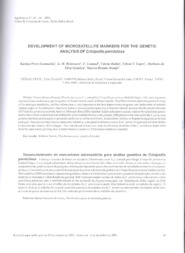Development of microsatelllte markers for the genetic analysis of Crinipellis perniciosa.
Development of microsatelllte markers for the genetic analysis of Crinipellis perniciosa.
Author(s): GRAMACHO, K. P.; RISTERUCCI, A. M.; LANAUD, C.; BAHIA, C.; LOPES, U. V.; GESTEIRA, A. da S.; ARAÚJO, M. R.
Summary: Witches' broom disease of cacao (Theobroma cacao L.), caused by Crinipellis perniciosa (Stahel) Singer, is the most importam disease of cacao in the cacao growing areas of South America and Caribbean Tslands. Very little is known about the genetic biology of the pathogen population, and this infonnation is very importam to the host improvement programs and deployment of resistant planting material. A collaborative America Countries intemational program was initiated to identify and describe the genetic diversity of Crinipellis perniciosa in South America. Microsatellites (SSR) constitute highly infonnative genetic markers for popuJation genetic studies due to their co-dominant and multiallelic nature and distribution in the genome. SSR primers were searched in the C.perniciosa genome data base and designed as potential candidates to define an efficient, standardized, molecular fingerprinting protocol for this pathogen. These primers have been evaluated for reliability, widespread disttibution across the C.perniciosa genome and their ability to discriminate isolates ofthis fungus. The final objective here is to study the diversity structure ofthe C. perniciosa population from the main cacao growing area in South America countries. Preliminary results are reported.
Publication year: 2005
Types of publication: Journal article
Unit: Embrapa Cassava & Fruits
Observation
Some of Embrapa's publications are published as ePub files. To read them, use or download one of the following free software options to your computer or mobile device. Android: Google Play Books; IOS: iBooks; Windows and Linux: Calibre.
Access other publications
Access the Agricultural Research Database (BDPA) to consult Embrapa's full library collection and records.
Visit Embrapa Bookstore to purchase books and other publications sold by Embrapa.

